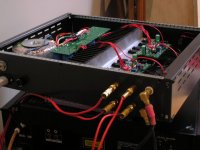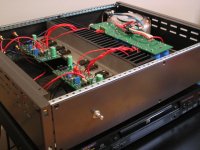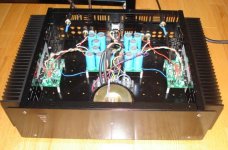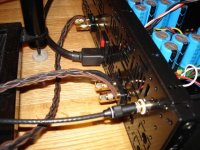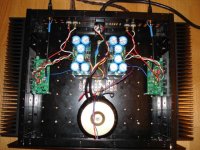I have just received my SKA kit and instructions.
The C1 in the SKA is an input blocking capacitor in case there is DC coming from your preamp. With an input impedance of 27K you could use a 1uF polyester which would fit in the PCB space or better but larger is polypropylene - like Wima MKP.
But you only need one if you have DC coming from your preamp.
The C1 in the SKA is an input blocking capacitor in case there is DC coming from your preamp. With an input impedance of 27K you could use a 1uF polyester which would fit in the PCB space or better but larger is polypropylene - like Wima MKP.
But you only need one if you have DC coming from your preamp.
Space in PCB is limited so C1 soldered in RCA-input connector should be better solution. Then we can use better quality (bigger) caps. Greg has said that polyester is not good, better to use polypropylene.
Hi,
careful, this could be bad advice.
If you choose to run two or more amplifiers from a single source, then all the amps except one MUST have a blocking cap on them to prevent the input bias currents interfering with each other.
If you do plan to run multiple amps off one source then the lowest frequency amp is the ONE to omit the blocking cap from.
I do run multiple amps in a passive bi-amped system and I plan to add a sub-bass to my existing (DC blocked) three amps per channel set-up. I have the option on either the Leach clone or KSA50 Klone to bypass the input DC blocking cap. Problem solved.
careful, this could be bad advice.
But you only need one if you have DC coming from your preamp.
If you choose to run two or more amplifiers from a single source, then all the amps except one MUST have a blocking cap on them to prevent the input bias currents interfering with each other.
If you do plan to run multiple amps off one source then the lowest frequency amp is the ONE to omit the blocking cap from.
I do run multiple amps in a passive bi-amped system and I plan to add a sub-bass to my existing (DC blocked) three amps per channel set-up. I have the option on either the Leach clone or KSA50 Klone to bypass the input DC blocking cap. Problem solved.
That's an interesting box Sandro - is it Australian?
Are you using multiturn trimpots?
so how's it sound?
Are you using multiturn trimpots?
so how's it sound?
Greg Erskine is correct
Box is Jaycar catalog no. HB5125 $79
Trimpot is Jaycar RP8510 10K log
Sounds superb. It'll form the basis
of a Linkwitz system most likely
Box is Jaycar catalog no. HB5125 $79
Trimpot is Jaycar RP8510 10K log
Sounds superb. It'll form the basis
of a Linkwitz system most likely
Hi all
Saw Greg was having a special on his 150D/300D SKA kits, and, thought that I would let you all know. Refer to the following URL ... http://www.audiocircle.com/circles/viewtopic.php?t=27344

Saw Greg was having a special on his 150D/300D SKA kits, and, thought that I would let you all know. Refer to the following URL ... http://www.audiocircle.com/circles/viewtopic.php?t=27344

Re: SKA: work in progress
First time I have seen your pics. Very nice ... How is it sounding?

Hi sandro600sandro600 said:A few pics of my SKA
First time I have seen your pics. Very nice ... How is it sounding?

Hi all
Saw Greg was having a special on his 150D/300D SKA kits, and, thought that I would let you all know. Refer to the following URL ... http://www.audiocircle.com/circles/viewtopic.php?t=27344

Saw Greg was having a special on his 150D/300D SKA kits, and, thought that I would let you all know. Refer to the following URL ... http://www.audiocircle.com/circles/viewtopic.php?t=27344

Second listen - GB150D
Just about finished my GB150D - just final bias and put the cover on. So far I'm just blown away by the dynamics and detail. When I first connected up a couple of days ago and turned it on the silence was so uncanny I thought there was some kind of issue. It was a remarkable experience to hear the sound coming out of that silence as I turned up the volume.
The blue led shown in this view is still a bit bright - even after adding a 220R and then a 2k6 resistor so I think I'll try adding one more to try and tone it down before closing up.
rez
Just about finished my GB150D - just final bias and put the cover on. So far I'm just blown away by the dynamics and detail. When I first connected up a couple of days ago and turned it on the silence was so uncanny I thought there was some kind of issue. It was a remarkable experience to hear the sound coming out of that silence as I turned up the volume.
The blue led shown in this view is still a bit bright - even after adding a 220R and then a 2k6 resistor so I think I'll try adding one more to try and tone it down before closing up.
rez
Attachments
Rez, That is some mighty fine panel work.
Would you be able to post a pic of the front panel ?
It just looks so good.
What kind of cable is it going from
the input RCA to the input on the PCB?
Have to agree with your impressions of its
qualities as an amp.
KLe : It sounds exceptional .. Ive been looking
for a way of powering Linkwitz Orions.
Ive found it.
Would you be able to post a pic of the front panel ?
It just looks so good.
What kind of cable is it going from
the input RCA to the input on the PCB?
Have to agree with your impressions of its
qualities as an amp.
KLe : It sounds exceptional .. Ive been looking
for a way of powering Linkwitz Orions.
Ive found it.
Wish I could take credit for the panel work but the chassis is a kit from DesignBuildListen in New Zealand. Although it was a bit tricky to implement I used Belden 89259 on the basis that if it was good for the Jon Risch formula IC it would be good to carry the same wire from the rca to the amp board. Will post another pic when I've finished biasing, tweaking the front LED and covering it up.
That's a nice chassis Rez.
I'm building my GB150D and GB150S modules this weekend but waiting for Greg's new chassis - only a couple of weeks away, I am told.
I'm building my GB150D and GB150S modules this weekend but waiting for Greg's new chassis - only a couple of weeks away, I am told.
- Status
- Not open for further replies.
- Home
- Amplifiers
- Solid State
- Simple Killer Amp Constructor Thread

